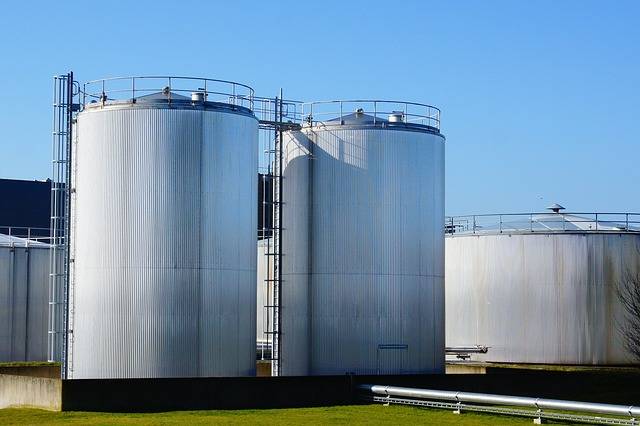Commercial property for storage of flammable and combustible oil-products with a flash point up to 230ºС can be divided into two groups:
- independent units (enterprise);
- structural units of another enterprise.
Independent storage facilities include reception, and equipment for storage and distribution of oil-products to consumers. They are called tank farms.
Tank farms are usually located in a safe distance from neighboring industrial sites, settlements, natural arrays, etc.
Tank farms are planned in accordance with regional planning. In general, they include repair shops, labs, fire protection equipment, energy and communication facilities, boilers, industrial pipelines and utility networks, dispensers, drains and loading devices, reservoir parks, etc.
Tank farms have different capacity of tanks and subject to fire considerations. The “capacity of tank farm” means a full volume of its tanks and reservoirs.
Part of an enterprise facilities for receiving, storage and distribution of oil-products, are used for needs of enterprise. This group includes fleet, river and seaports, railway stations, airports and industrial warehouses.
According to the nature of operations there are transshipment and distribution tank farms.
Transshipment tank farms are used for handling oil-products from one transport mode to another. They are used for circulations of relatively large volumes of oil-products, as well as for supplying smaller volumes to distribution tank farms.
Transshipment tank farms are characterized by a minimum period of storage (usually 6-24 days), except when transshipment bases are located on waterways with possible freezing conditions.
Most often, transshipment tank farms are located at railway lines, navigable river banks, seaports, etc.
Sea and river transshipment tank farms are involved in transshipment of oil from pipeline transport or rail transport into tankers or vice versa. In some cases, such tank farms can load the oil to a similar mode of transport (sea tanker – river barge).
Transshipment tank farms are characterized by powerful pumping facilities and advanced loading-unloading devices that are indispensable for fast transshipment.
Transshipment tank farms usually have a capacity over 30,000 gl.
Distribution tank farms provide users with oil-products. The main difference from transshipment tank farms is their lower capacity, short time storage of oil-products and a limited service area.
As a rule, distribution tank farm capacity is not more than 30,000 gl, but a larger capacity is also used.
Distribution tank farms are involved in the turnover of oil-products from railway, water, road and pipeline transport. Unloading is carried out into small containers on road transport, rail transport and small barges.
Depending on the nature of operations distribution tank farms are classified by the following types: regional and district, water, rail and water-rail. They are arranged to ensure the best possible customer service, in a strict compliance with fire and health regulations, as well as ensuring low mileage of vehicle movement from consumer to tank farm.
Distribution tank farms are located on main pipelines, also there are inland tank farms. As a rule, tank farms of the first type are built not far from main pipelines and are occasionally fed from them. Oil-products are supplied onto motor transport. The tank farms of the second type are situated far from water- and railways, and all operations with oil-products are held by motor transport.
Inland tank farms release petroleum products to agricultural and other enterprises, linked with these tank farms. During winter, when oil consumption is significantly reduced, inland tank farms are used as storage terminals for stock accumulation to be used later for spring field works.
Mobile distribution tank farms are used for the development of new land. They are necessary to supply consumers with oil-products during the period of construction of stationary tank farms. They are equipped inside railway trains and contain housing accommodations, power stations, pumping plants, boilers and tanks.
Commercial tank farms are oil storages designed for receiving oil products from water transport, rail transport and pipeline transport and store keeping, providing smooth operation, preparing oil for processing, as well as its supply back to the pipeline.
All abovementioned tank farms are interrelated and solve a common problem of supplying consumers with oil-products with maximum efficiency and lowest possible operating costs.
To solve these tasks, technical equipment of tank farms must comply with the following requirements:
- The capacity of a tank farm should be sufficient for storage of required amount of oil-products.
- The pipelines must be designed for simultaneous loading and offloading on various types of oil-products without mixing them.
- Pumping units and oil machinery must comply with regulations of Up-Load and Off-Load of various types of oil-products.
Basic operations performed at tank farms can be divided into two groups: main operations and secondary operations.
Main operations include:
- Receiving of oil-products from rail and water transport, as well as from main pipelines.
- Storage of oil-products in tanks and storage facilities.
- Oil-loading to tank wagons and tankers.
- Transfer to the main pipelines stations.
- Distribution through filling stations and storages.
Secondary operations:
- Heating of viscous oil-products when received, stored and distributed;
- Cleaning and dehydration of petroleum products;
- Regeneration (quality recovery) of used oils;
- Manufacturing and repair of small containers (barrels, cans).
Secondary operations are not conducted at all tank farms, without reasons for extra profit.

